Business Strategies Report: Clara Osbourne Technologies, USQ, 2017
VerifiedAdded on 2020/03/23
|27
|5822
|45
Report
AI Summary
This report, prepared for Dr. William Moulton Marston and Clara Osbourne Technologies, delves into crucial business strategies. It examines Porter's Five Forces Model, three generic strategies, and the importance of supply chain management. The report explores the benefits of Enterprise Resource Planning (ERP), including database management systems, and the advantages of Customer Relationship Management (CRM). Additionally, it analyzes the role of social media in business, outlining both its advantages and disadvantages. The report provides justifications, recommendations, and a comprehensive overview of strategies for achieving and maintaining a competitive advantage, offering valuable insights for business development and decision-making. The report also includes an Executive Summary, Table of Contents, References, and Appendices.
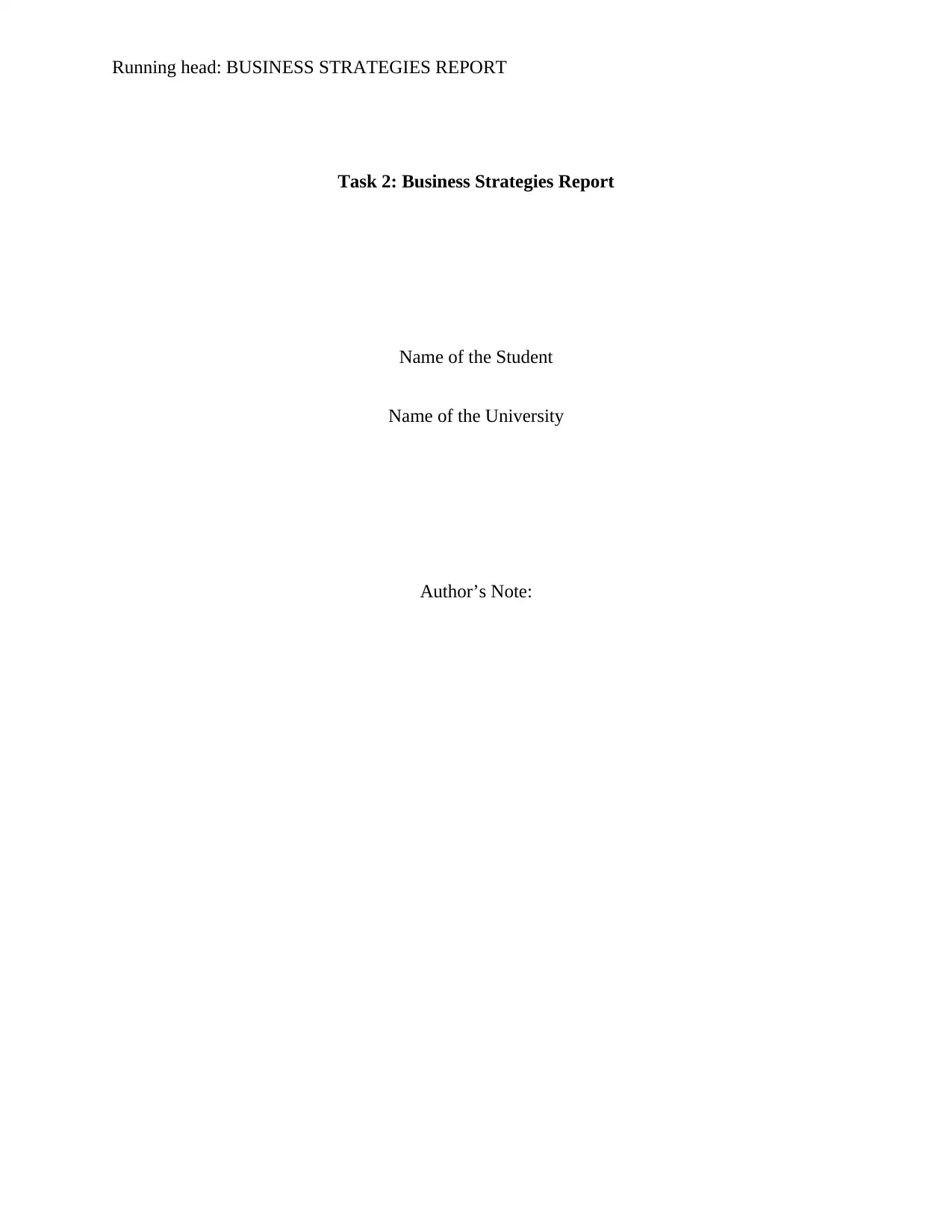
Running head: BUSINESS STRATEGIES REPORT
Task 2: Business Strategies Report
Name of the Student
Name of the University
Author’s Note:
Task 2: Business Strategies Report
Name of the Student
Name of the University
Author’s Note:
Paraphrase This Document
Need a fresh take? Get an instant paraphrase of this document with our AI Paraphraser
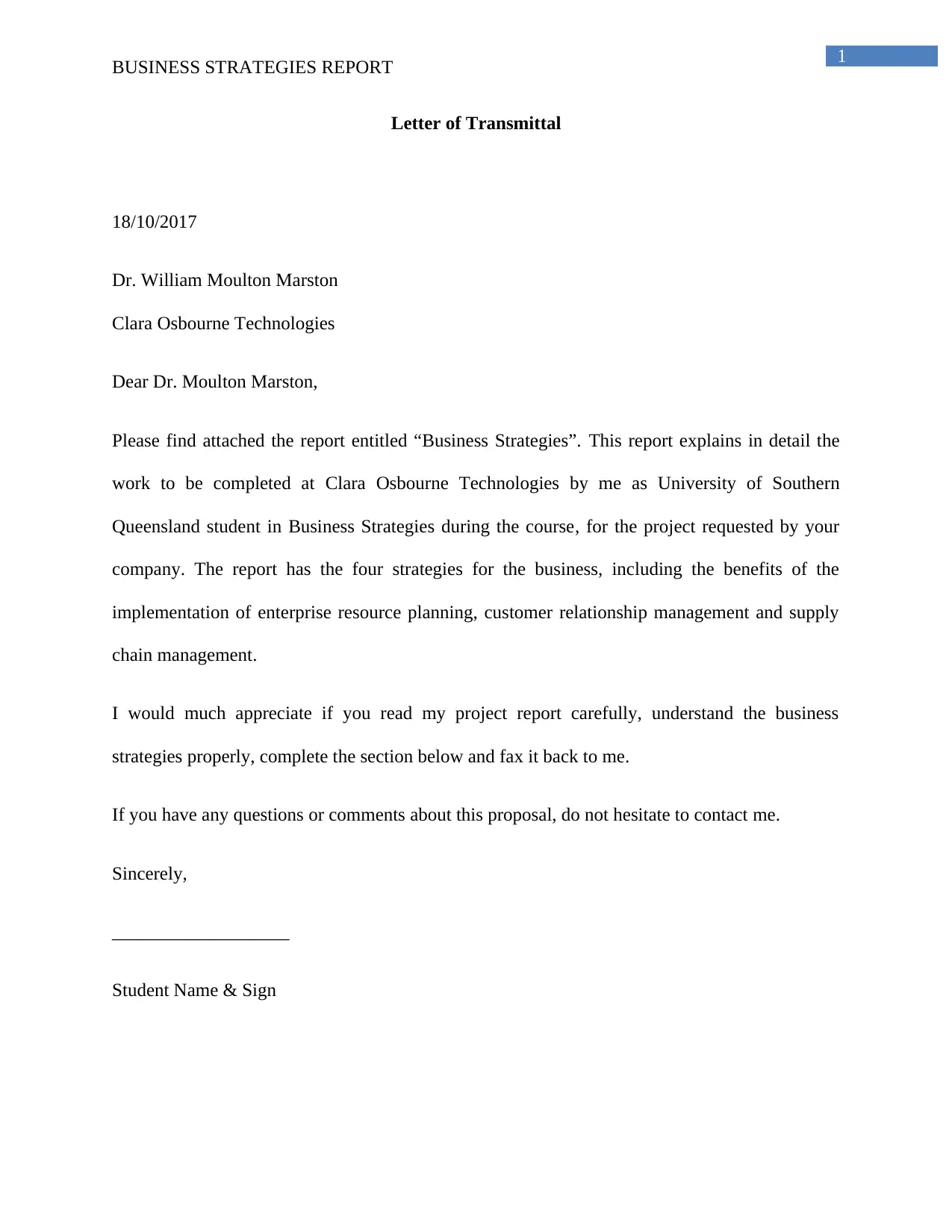
1
BUSINESS STRATEGIES REPORT
Letter of Transmittal
18/10/2017
Dr. William Moulton Marston
Clara Osbourne Technologies
Dear Dr. Moulton Marston,
Please find attached the report entitled “Business Strategies”. This report explains in detail the
work to be completed at Clara Osbourne Technologies by me as University of Southern
Queensland student in Business Strategies during the course, for the project requested by your
company. The report has the four strategies for the business, including the benefits of the
implementation of enterprise resource planning, customer relationship management and supply
chain management.
I would much appreciate if you read my project report carefully, understand the business
strategies properly, complete the section below and fax it back to me.
If you have any questions or comments about this proposal, do not hesitate to contact me.
Sincerely,
___________________
Student Name & Sign
BUSINESS STRATEGIES REPORT
Letter of Transmittal
18/10/2017
Dr. William Moulton Marston
Clara Osbourne Technologies
Dear Dr. Moulton Marston,
Please find attached the report entitled “Business Strategies”. This report explains in detail the
work to be completed at Clara Osbourne Technologies by me as University of Southern
Queensland student in Business Strategies during the course, for the project requested by your
company. The report has the four strategies for the business, including the benefits of the
implementation of enterprise resource planning, customer relationship management and supply
chain management.
I would much appreciate if you read my project report carefully, understand the business
strategies properly, complete the section below and fax it back to me.
If you have any questions or comments about this proposal, do not hesitate to contact me.
Sincerely,
___________________
Student Name & Sign
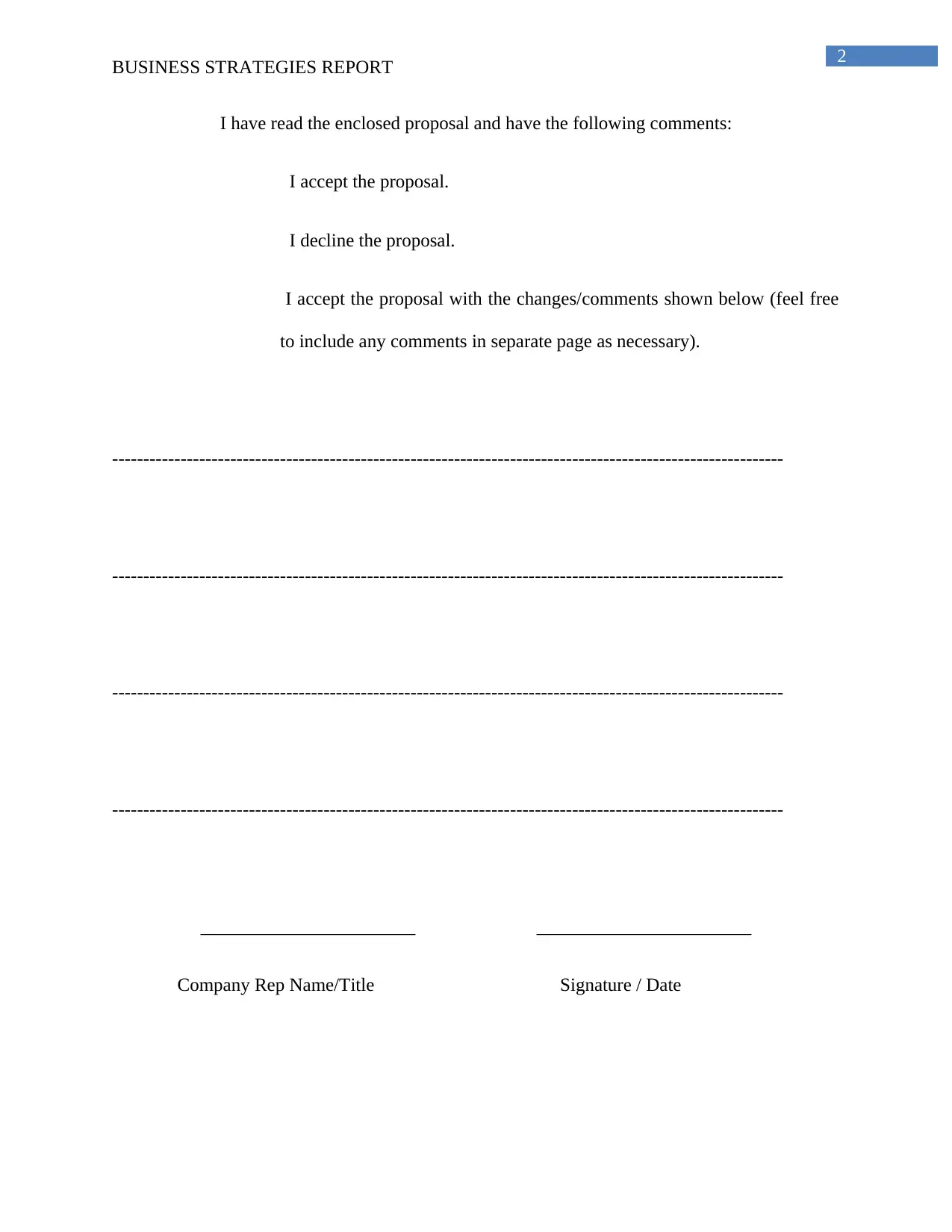
2
BUSINESS STRATEGIES REPORT
I have read the enclosed proposal and have the following comments:
I accept the proposal.
I decline the proposal.
I accept the proposal with the changes/comments shown below (feel free
to include any comments in separate page as necessary).
------------------------------------------------------------------------------------------------------------
------------------------------------------------------------------------------------------------------------
------------------------------------------------------------------------------------------------------------
------------------------------------------------------------------------------------------------------------
_______________________ _______________________
Company Rep Name/Title Signature / Date
BUSINESS STRATEGIES REPORT
I have read the enclosed proposal and have the following comments:
I accept the proposal.
I decline the proposal.
I accept the proposal with the changes/comments shown below (feel free
to include any comments in separate page as necessary).
------------------------------------------------------------------------------------------------------------
------------------------------------------------------------------------------------------------------------
------------------------------------------------------------------------------------------------------------
------------------------------------------------------------------------------------------------------------
_______________________ _______________________
Company Rep Name/Title Signature / Date
⊘ This is a preview!⊘
Do you want full access?
Subscribe today to unlock all pages.

Trusted by 1+ million students worldwide
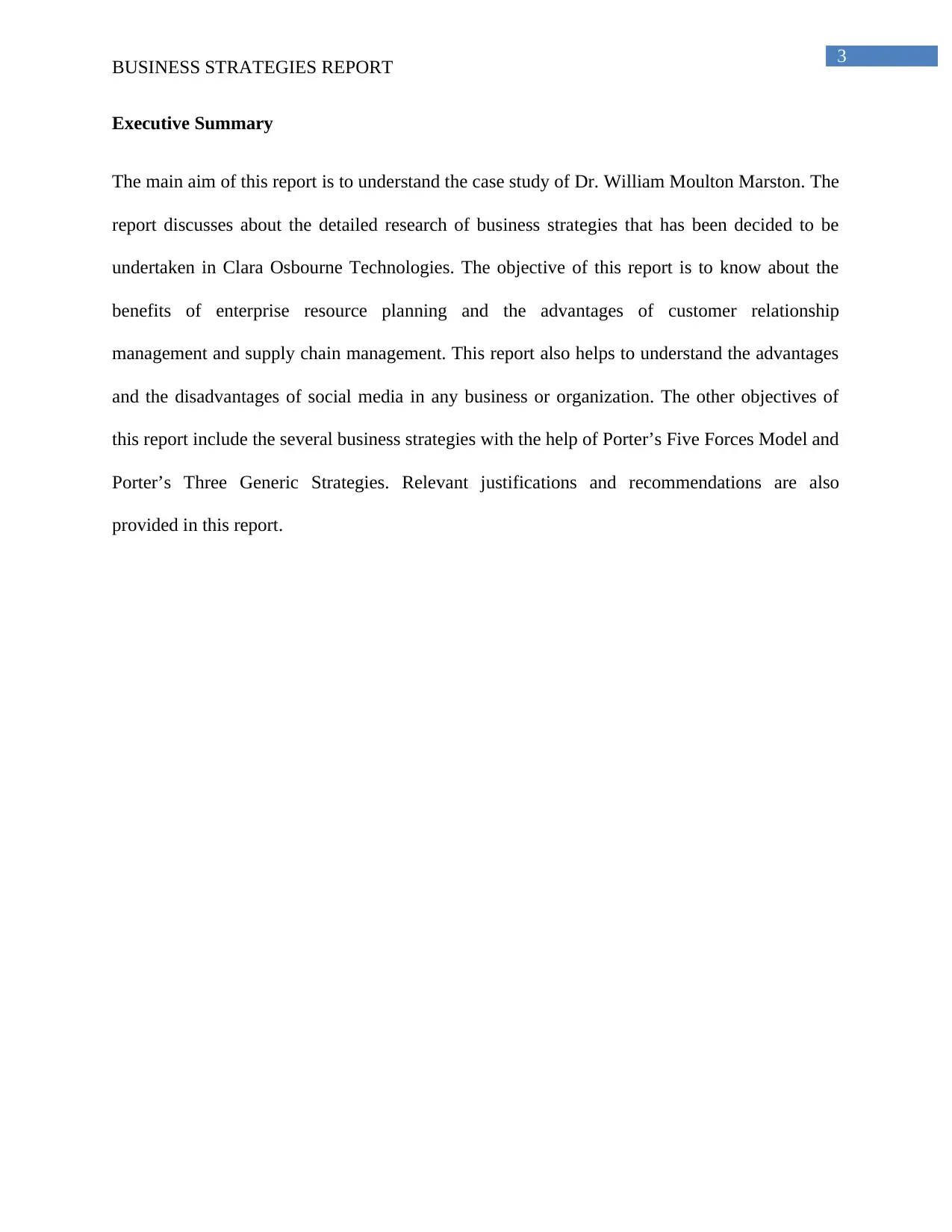
3
BUSINESS STRATEGIES REPORT
Executive Summary
The main aim of this report is to understand the case study of Dr. William Moulton Marston. The
report discusses about the detailed research of business strategies that has been decided to be
undertaken in Clara Osbourne Technologies. The objective of this report is to know about the
benefits of enterprise resource planning and the advantages of customer relationship
management and supply chain management. This report also helps to understand the advantages
and the disadvantages of social media in any business or organization. The other objectives of
this report include the several business strategies with the help of Porter’s Five Forces Model and
Porter’s Three Generic Strategies. Relevant justifications and recommendations are also
provided in this report.
BUSINESS STRATEGIES REPORT
Executive Summary
The main aim of this report is to understand the case study of Dr. William Moulton Marston. The
report discusses about the detailed research of business strategies that has been decided to be
undertaken in Clara Osbourne Technologies. The objective of this report is to know about the
benefits of enterprise resource planning and the advantages of customer relationship
management and supply chain management. This report also helps to understand the advantages
and the disadvantages of social media in any business or organization. The other objectives of
this report include the several business strategies with the help of Porter’s Five Forces Model and
Porter’s Three Generic Strategies. Relevant justifications and recommendations are also
provided in this report.
Paraphrase This Document
Need a fresh take? Get an instant paraphrase of this document with our AI Paraphraser
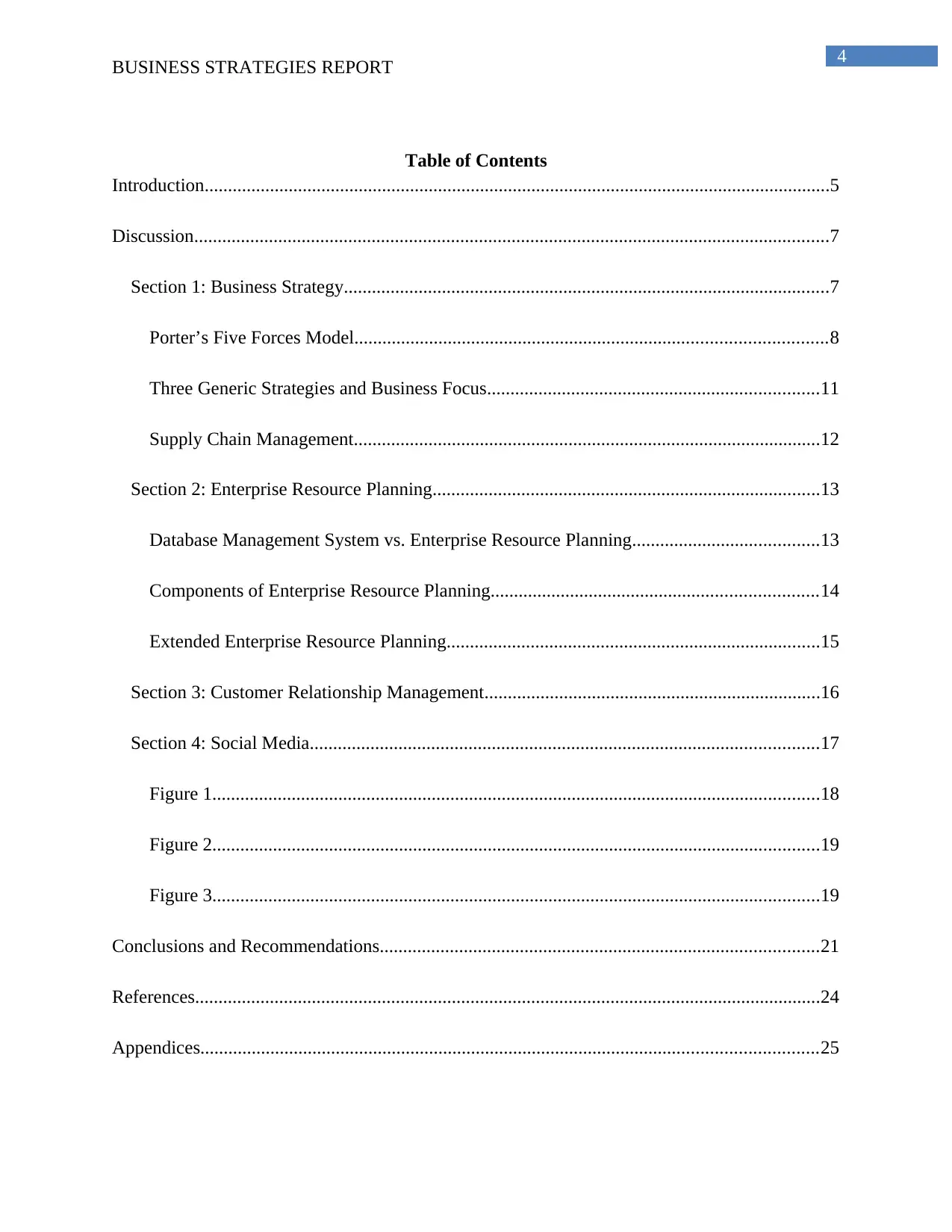
4
BUSINESS STRATEGIES REPORT
Table of Contents
Introduction......................................................................................................................................5
Discussion........................................................................................................................................7
Section 1: Business Strategy........................................................................................................7
Porter’s Five Forces Model.....................................................................................................8
Three Generic Strategies and Business Focus.......................................................................11
Supply Chain Management....................................................................................................12
Section 2: Enterprise Resource Planning...................................................................................13
Database Management System vs. Enterprise Resource Planning........................................13
Components of Enterprise Resource Planning......................................................................14
Extended Enterprise Resource Planning................................................................................15
Section 3: Customer Relationship Management........................................................................16
Section 4: Social Media.............................................................................................................17
Figure 1..................................................................................................................................18
Figure 2..................................................................................................................................19
Figure 3..................................................................................................................................19
Conclusions and Recommendations..............................................................................................21
References......................................................................................................................................24
Appendices....................................................................................................................................25
BUSINESS STRATEGIES REPORT
Table of Contents
Introduction......................................................................................................................................5
Discussion........................................................................................................................................7
Section 1: Business Strategy........................................................................................................7
Porter’s Five Forces Model.....................................................................................................8
Three Generic Strategies and Business Focus.......................................................................11
Supply Chain Management....................................................................................................12
Section 2: Enterprise Resource Planning...................................................................................13
Database Management System vs. Enterprise Resource Planning........................................13
Components of Enterprise Resource Planning......................................................................14
Extended Enterprise Resource Planning................................................................................15
Section 3: Customer Relationship Management........................................................................16
Section 4: Social Media.............................................................................................................17
Figure 1..................................................................................................................................18
Figure 2..................................................................................................................................19
Figure 3..................................................................................................................................19
Conclusions and Recommendations..............................................................................................21
References......................................................................................................................................24
Appendices....................................................................................................................................25
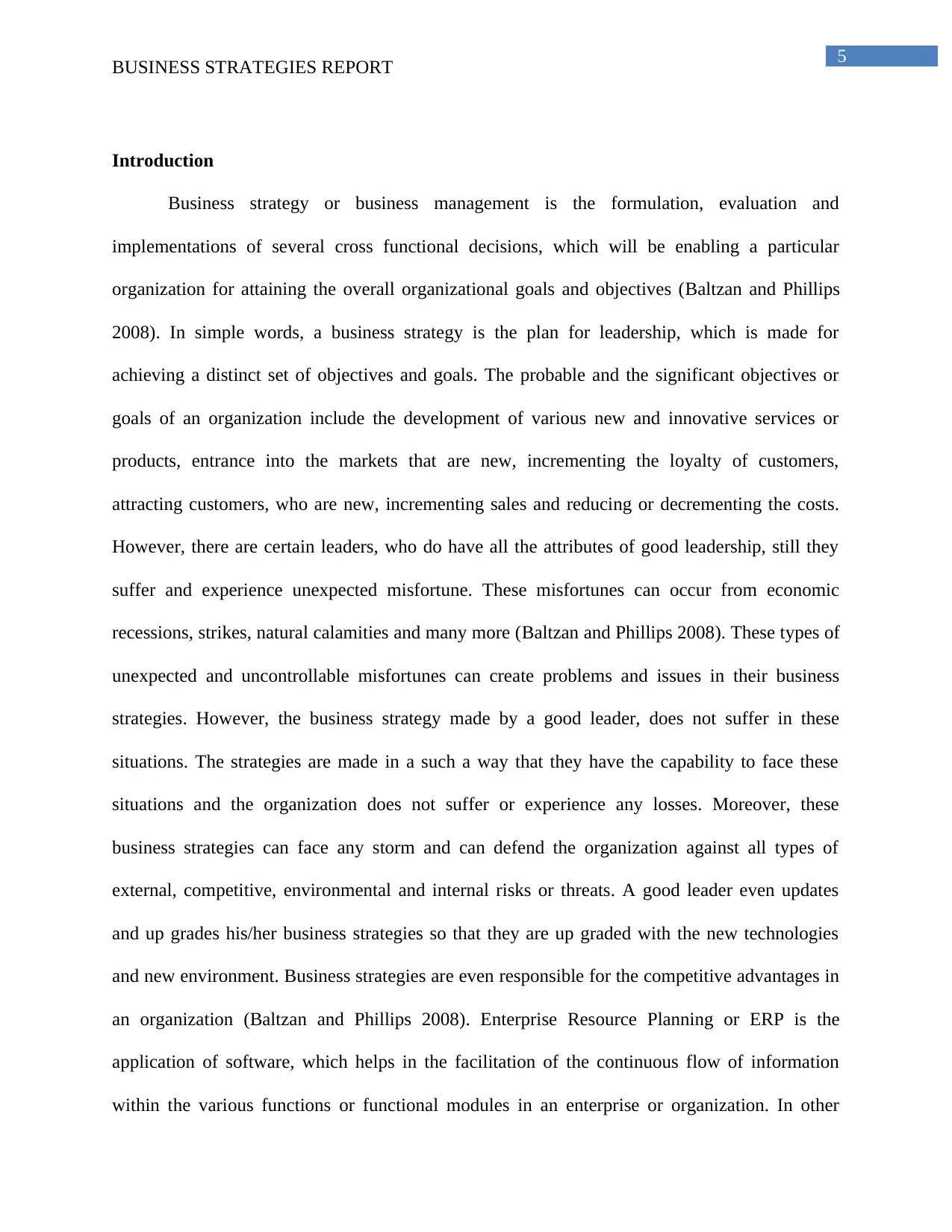
5
BUSINESS STRATEGIES REPORT
Introduction
Business strategy or business management is the formulation, evaluation and
implementations of several cross functional decisions, which will be enabling a particular
organization for attaining the overall organizational goals and objectives (Baltzan and Phillips
2008). In simple words, a business strategy is the plan for leadership, which is made for
achieving a distinct set of objectives and goals. The probable and the significant objectives or
goals of an organization include the development of various new and innovative services or
products, entrance into the markets that are new, incrementing the loyalty of customers,
attracting customers, who are new, incrementing sales and reducing or decrementing the costs.
However, there are certain leaders, who do have all the attributes of good leadership, still they
suffer and experience unexpected misfortune. These misfortunes can occur from economic
recessions, strikes, natural calamities and many more (Baltzan and Phillips 2008). These types of
unexpected and uncontrollable misfortunes can create problems and issues in their business
strategies. However, the business strategy made by a good leader, does not suffer in these
situations. The strategies are made in a such a way that they have the capability to face these
situations and the organization does not suffer or experience any losses. Moreover, these
business strategies can face any storm and can defend the organization against all types of
external, competitive, environmental and internal risks or threats. A good leader even updates
and up grades his/her business strategies so that they are up graded with the new technologies
and new environment. Business strategies are even responsible for the competitive advantages in
an organization (Baltzan and Phillips 2008). Enterprise Resource Planning or ERP is the
application of software, which helps in the facilitation of the continuous flow of information
within the various functions or functional modules in an enterprise or organization. In other
BUSINESS STRATEGIES REPORT
Introduction
Business strategy or business management is the formulation, evaluation and
implementations of several cross functional decisions, which will be enabling a particular
organization for attaining the overall organizational goals and objectives (Baltzan and Phillips
2008). In simple words, a business strategy is the plan for leadership, which is made for
achieving a distinct set of objectives and goals. The probable and the significant objectives or
goals of an organization include the development of various new and innovative services or
products, entrance into the markets that are new, incrementing the loyalty of customers,
attracting customers, who are new, incrementing sales and reducing or decrementing the costs.
However, there are certain leaders, who do have all the attributes of good leadership, still they
suffer and experience unexpected misfortune. These misfortunes can occur from economic
recessions, strikes, natural calamities and many more (Baltzan and Phillips 2008). These types of
unexpected and uncontrollable misfortunes can create problems and issues in their business
strategies. However, the business strategy made by a good leader, does not suffer in these
situations. The strategies are made in a such a way that they have the capability to face these
situations and the organization does not suffer or experience any losses. Moreover, these
business strategies can face any storm and can defend the organization against all types of
external, competitive, environmental and internal risks or threats. A good leader even updates
and up grades his/her business strategies so that they are up graded with the new technologies
and new environment. Business strategies are even responsible for the competitive advantages in
an organization (Baltzan and Phillips 2008). Enterprise Resource Planning or ERP is the
application of software, which helps in the facilitation of the continuous flow of information
within the various functions or functional modules in an enterprise or organization. In other
⊘ This is a preview!⊘
Do you want full access?
Subscribe today to unlock all pages.

Trusted by 1+ million students worldwide
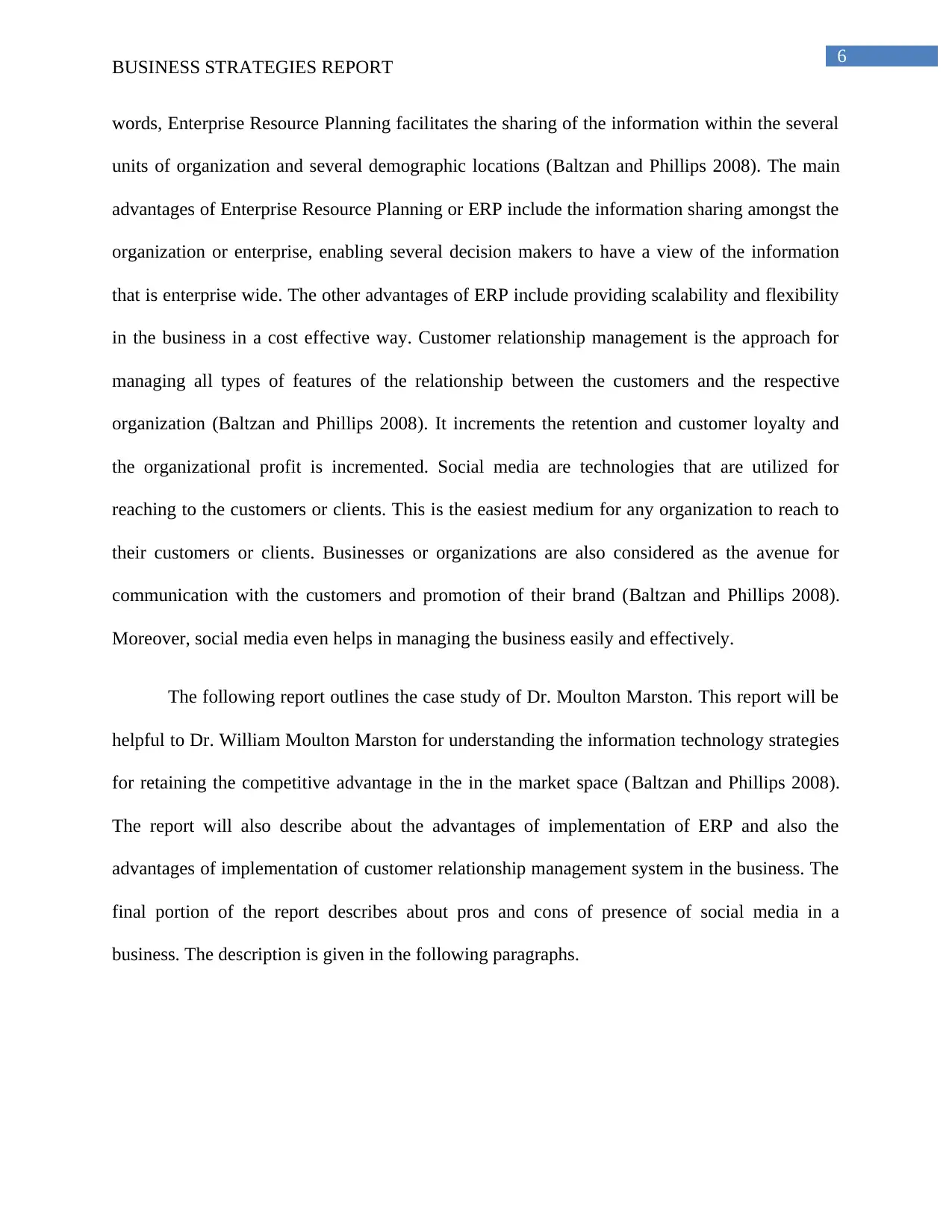
6
BUSINESS STRATEGIES REPORT
words, Enterprise Resource Planning facilitates the sharing of the information within the several
units of organization and several demographic locations (Baltzan and Phillips 2008). The main
advantages of Enterprise Resource Planning or ERP include the information sharing amongst the
organization or enterprise, enabling several decision makers to have a view of the information
that is enterprise wide. The other advantages of ERP include providing scalability and flexibility
in the business in a cost effective way. Customer relationship management is the approach for
managing all types of features of the relationship between the customers and the respective
organization (Baltzan and Phillips 2008). It increments the retention and customer loyalty and
the organizational profit is incremented. Social media are technologies that are utilized for
reaching to the customers or clients. This is the easiest medium for any organization to reach to
their customers or clients. Businesses or organizations are also considered as the avenue for
communication with the customers and promotion of their brand (Baltzan and Phillips 2008).
Moreover, social media even helps in managing the business easily and effectively.
The following report outlines the case study of Dr. Moulton Marston. This report will be
helpful to Dr. William Moulton Marston for understanding the information technology strategies
for retaining the competitive advantage in the in the market space (Baltzan and Phillips 2008).
The report will also describe about the advantages of implementation of ERP and also the
advantages of implementation of customer relationship management system in the business. The
final portion of the report describes about pros and cons of presence of social media in a
business. The description is given in the following paragraphs.
BUSINESS STRATEGIES REPORT
words, Enterprise Resource Planning facilitates the sharing of the information within the several
units of organization and several demographic locations (Baltzan and Phillips 2008). The main
advantages of Enterprise Resource Planning or ERP include the information sharing amongst the
organization or enterprise, enabling several decision makers to have a view of the information
that is enterprise wide. The other advantages of ERP include providing scalability and flexibility
in the business in a cost effective way. Customer relationship management is the approach for
managing all types of features of the relationship between the customers and the respective
organization (Baltzan and Phillips 2008). It increments the retention and customer loyalty and
the organizational profit is incremented. Social media are technologies that are utilized for
reaching to the customers or clients. This is the easiest medium for any organization to reach to
their customers or clients. Businesses or organizations are also considered as the avenue for
communication with the customers and promotion of their brand (Baltzan and Phillips 2008).
Moreover, social media even helps in managing the business easily and effectively.
The following report outlines the case study of Dr. Moulton Marston. This report will be
helpful to Dr. William Moulton Marston for understanding the information technology strategies
for retaining the competitive advantage in the in the market space (Baltzan and Phillips 2008).
The report will also describe about the advantages of implementation of ERP and also the
advantages of implementation of customer relationship management system in the business. The
final portion of the report describes about pros and cons of presence of social media in a
business. The description is given in the following paragraphs.
Paraphrase This Document
Need a fresh take? Get an instant paraphrase of this document with our AI Paraphraser
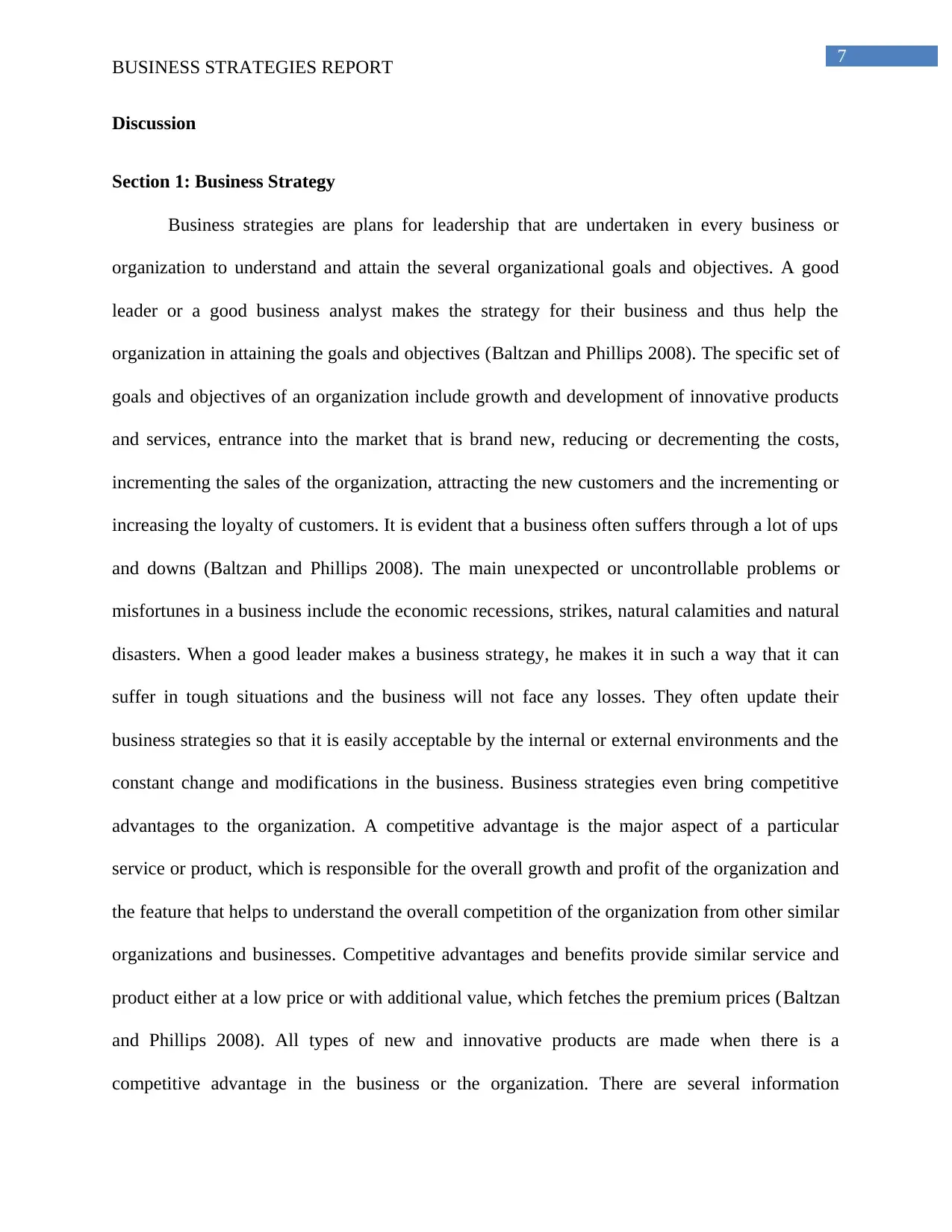
7
BUSINESS STRATEGIES REPORT
Discussion
Section 1: Business Strategy
Business strategies are plans for leadership that are undertaken in every business or
organization to understand and attain the several organizational goals and objectives. A good
leader or a good business analyst makes the strategy for their business and thus help the
organization in attaining the goals and objectives (Baltzan and Phillips 2008). The specific set of
goals and objectives of an organization include growth and development of innovative products
and services, entrance into the market that is brand new, reducing or decrementing the costs,
incrementing the sales of the organization, attracting the new customers and the incrementing or
increasing the loyalty of customers. It is evident that a business often suffers through a lot of ups
and downs (Baltzan and Phillips 2008). The main unexpected or uncontrollable problems or
misfortunes in a business include the economic recessions, strikes, natural calamities and natural
disasters. When a good leader makes a business strategy, he makes it in such a way that it can
suffer in tough situations and the business will not face any losses. They often update their
business strategies so that it is easily acceptable by the internal or external environments and the
constant change and modifications in the business. Business strategies even bring competitive
advantages to the organization. A competitive advantage is the major aspect of a particular
service or product, which is responsible for the overall growth and profit of the organization and
the feature that helps to understand the overall competition of the organization from other similar
organizations and businesses. Competitive advantages and benefits provide similar service and
product either at a low price or with additional value, which fetches the premium prices (Baltzan
and Phillips 2008). All types of new and innovative products are made when there is a
competitive advantage in the business or the organization. There are several information
BUSINESS STRATEGIES REPORT
Discussion
Section 1: Business Strategy
Business strategies are plans for leadership that are undertaken in every business or
organization to understand and attain the several organizational goals and objectives. A good
leader or a good business analyst makes the strategy for their business and thus help the
organization in attaining the goals and objectives (Baltzan and Phillips 2008). The specific set of
goals and objectives of an organization include growth and development of innovative products
and services, entrance into the market that is brand new, reducing or decrementing the costs,
incrementing the sales of the organization, attracting the new customers and the incrementing or
increasing the loyalty of customers. It is evident that a business often suffers through a lot of ups
and downs (Baltzan and Phillips 2008). The main unexpected or uncontrollable problems or
misfortunes in a business include the economic recessions, strikes, natural calamities and natural
disasters. When a good leader makes a business strategy, he makes it in such a way that it can
suffer in tough situations and the business will not face any losses. They often update their
business strategies so that it is easily acceptable by the internal or external environments and the
constant change and modifications in the business. Business strategies even bring competitive
advantages to the organization. A competitive advantage is the major aspect of a particular
service or product, which is responsible for the overall growth and profit of the organization and
the feature that helps to understand the overall competition of the organization from other similar
organizations and businesses. Competitive advantages and benefits provide similar service and
product either at a low price or with additional value, which fetches the premium prices (Baltzan
and Phillips 2008). All types of new and innovative products are made when there is a
competitive advantage in the business or the organization. There are several information
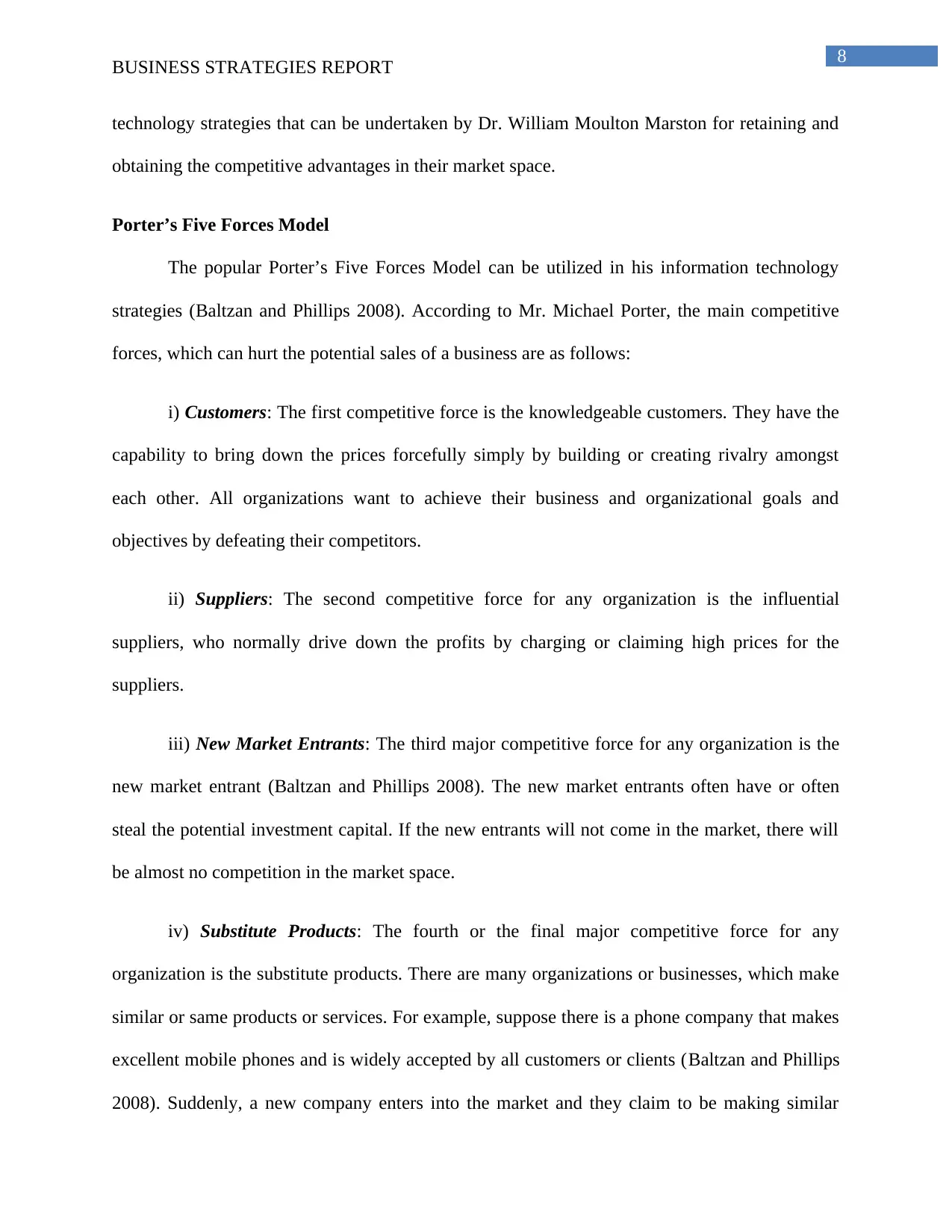
8
BUSINESS STRATEGIES REPORT
technology strategies that can be undertaken by Dr. William Moulton Marston for retaining and
obtaining the competitive advantages in their market space.
Porter’s Five Forces Model
The popular Porter’s Five Forces Model can be utilized in his information technology
strategies (Baltzan and Phillips 2008). According to Mr. Michael Porter, the main competitive
forces, which can hurt the potential sales of a business are as follows:
i) Customers: The first competitive force is the knowledgeable customers. They have the
capability to bring down the prices forcefully simply by building or creating rivalry amongst
each other. All organizations want to achieve their business and organizational goals and
objectives by defeating their competitors.
ii) Suppliers: The second competitive force for any organization is the influential
suppliers, who normally drive down the profits by charging or claiming high prices for the
suppliers.
iii) New Market Entrants: The third major competitive force for any organization is the
new market entrant (Baltzan and Phillips 2008). The new market entrants often have or often
steal the potential investment capital. If the new entrants will not come in the market, there will
be almost no competition in the market space.
iv) Substitute Products: The fourth or the final major competitive force for any
organization is the substitute products. There are many organizations or businesses, which make
similar or same products or services. For example, suppose there is a phone company that makes
excellent mobile phones and is widely accepted by all customers or clients (Baltzan and Phillips
2008). Suddenly, a new company enters into the market and they claim to be making similar
BUSINESS STRATEGIES REPORT
technology strategies that can be undertaken by Dr. William Moulton Marston for retaining and
obtaining the competitive advantages in their market space.
Porter’s Five Forces Model
The popular Porter’s Five Forces Model can be utilized in his information technology
strategies (Baltzan and Phillips 2008). According to Mr. Michael Porter, the main competitive
forces, which can hurt the potential sales of a business are as follows:
i) Customers: The first competitive force is the knowledgeable customers. They have the
capability to bring down the prices forcefully simply by building or creating rivalry amongst
each other. All organizations want to achieve their business and organizational goals and
objectives by defeating their competitors.
ii) Suppliers: The second competitive force for any organization is the influential
suppliers, who normally drive down the profits by charging or claiming high prices for the
suppliers.
iii) New Market Entrants: The third major competitive force for any organization is the
new market entrant (Baltzan and Phillips 2008). The new market entrants often have or often
steal the potential investment capital. If the new entrants will not come in the market, there will
be almost no competition in the market space.
iv) Substitute Products: The fourth or the final major competitive force for any
organization is the substitute products. There are many organizations or businesses, which make
similar or same products or services. For example, suppose there is a phone company that makes
excellent mobile phones and is widely accepted by all customers or clients (Baltzan and Phillips
2008). Suddenly, a new company enters into the market and they claim to be making similar
⊘ This is a preview!⊘
Do you want full access?
Subscribe today to unlock all pages.

Trusted by 1+ million students worldwide
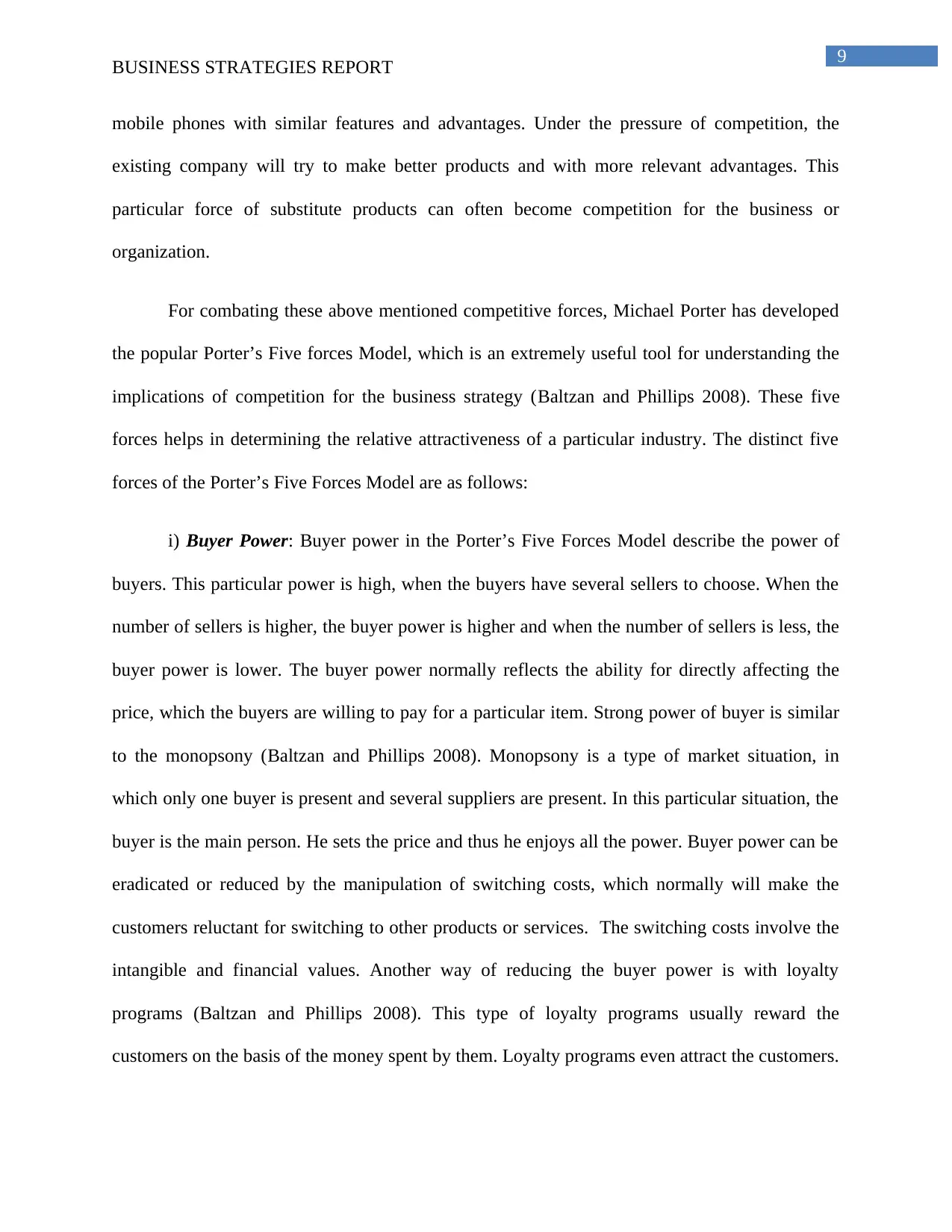
9
BUSINESS STRATEGIES REPORT
mobile phones with similar features and advantages. Under the pressure of competition, the
existing company will try to make better products and with more relevant advantages. This
particular force of substitute products can often become competition for the business or
organization.
For combating these above mentioned competitive forces, Michael Porter has developed
the popular Porter’s Five forces Model, which is an extremely useful tool for understanding the
implications of competition for the business strategy (Baltzan and Phillips 2008). These five
forces helps in determining the relative attractiveness of a particular industry. The distinct five
forces of the Porter’s Five Forces Model are as follows:
i) Buyer Power: Buyer power in the Porter’s Five Forces Model describe the power of
buyers. This particular power is high, when the buyers have several sellers to choose. When the
number of sellers is higher, the buyer power is higher and when the number of sellers is less, the
buyer power is lower. The buyer power normally reflects the ability for directly affecting the
price, which the buyers are willing to pay for a particular item. Strong power of buyer is similar
to the monopsony (Baltzan and Phillips 2008). Monopsony is a type of market situation, in
which only one buyer is present and several suppliers are present. In this particular situation, the
buyer is the main person. He sets the price and thus he enjoys all the power. Buyer power can be
eradicated or reduced by the manipulation of switching costs, which normally will make the
customers reluctant for switching to other products or services. The switching costs involve the
intangible and financial values. Another way of reducing the buyer power is with loyalty
programs (Baltzan and Phillips 2008). This type of loyalty programs usually reward the
customers on the basis of the money spent by them. Loyalty programs even attract the customers.
BUSINESS STRATEGIES REPORT
mobile phones with similar features and advantages. Under the pressure of competition, the
existing company will try to make better products and with more relevant advantages. This
particular force of substitute products can often become competition for the business or
organization.
For combating these above mentioned competitive forces, Michael Porter has developed
the popular Porter’s Five forces Model, which is an extremely useful tool for understanding the
implications of competition for the business strategy (Baltzan and Phillips 2008). These five
forces helps in determining the relative attractiveness of a particular industry. The distinct five
forces of the Porter’s Five Forces Model are as follows:
i) Buyer Power: Buyer power in the Porter’s Five Forces Model describe the power of
buyers. This particular power is high, when the buyers have several sellers to choose. When the
number of sellers is higher, the buyer power is higher and when the number of sellers is less, the
buyer power is lower. The buyer power normally reflects the ability for directly affecting the
price, which the buyers are willing to pay for a particular item. Strong power of buyer is similar
to the monopsony (Baltzan and Phillips 2008). Monopsony is a type of market situation, in
which only one buyer is present and several suppliers are present. In this particular situation, the
buyer is the main person. He sets the price and thus he enjoys all the power. Buyer power can be
eradicated or reduced by the manipulation of switching costs, which normally will make the
customers reluctant for switching to other products or services. The switching costs involve the
intangible and financial values. Another way of reducing the buyer power is with loyalty
programs (Baltzan and Phillips 2008). This type of loyalty programs usually reward the
customers on the basis of the money spent by them. Loyalty programs even attract the customers.
Paraphrase This Document
Need a fresh take? Get an instant paraphrase of this document with our AI Paraphraser
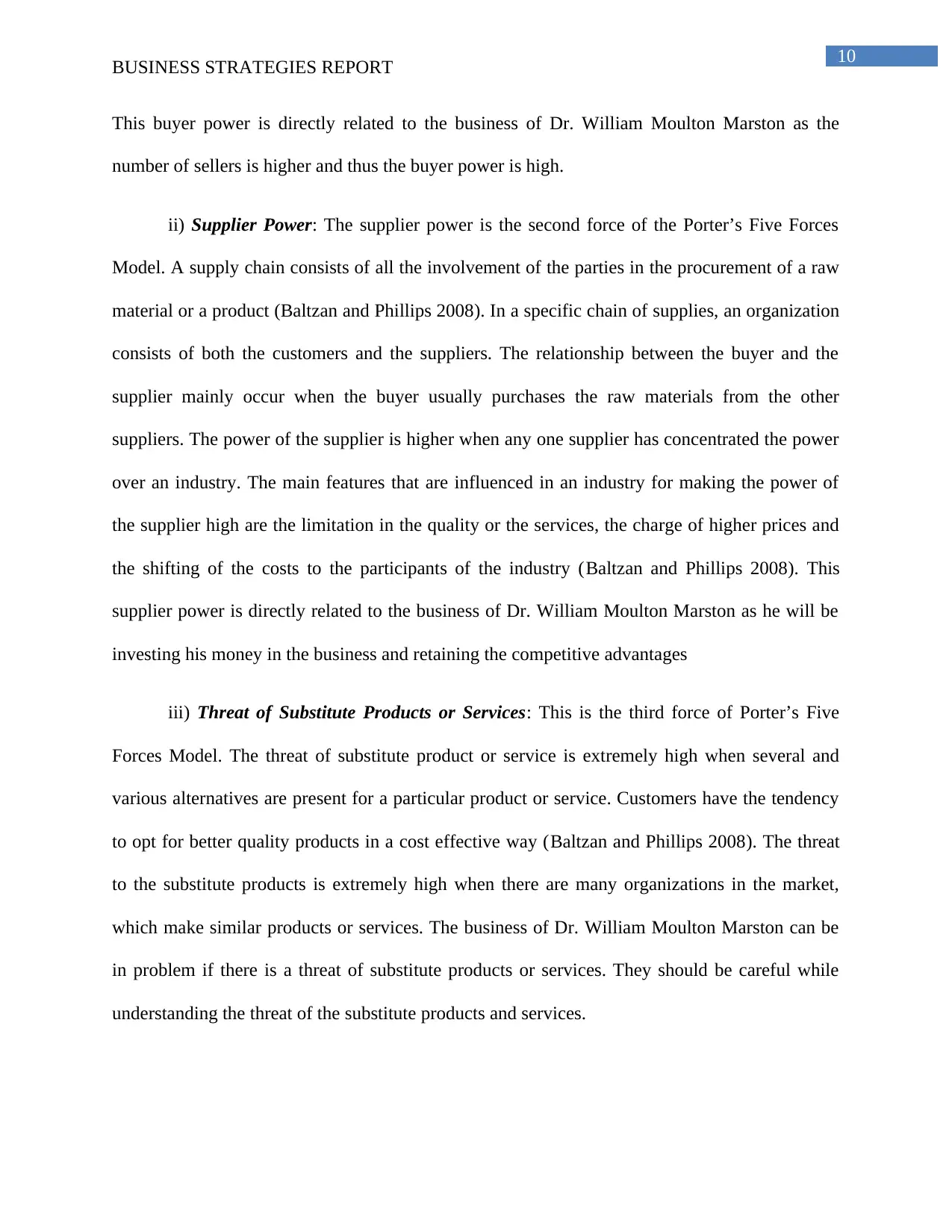
10
BUSINESS STRATEGIES REPORT
This buyer power is directly related to the business of Dr. William Moulton Marston as the
number of sellers is higher and thus the buyer power is high.
ii) Supplier Power: The supplier power is the second force of the Porter’s Five Forces
Model. A supply chain consists of all the involvement of the parties in the procurement of a raw
material or a product (Baltzan and Phillips 2008). In a specific chain of supplies, an organization
consists of both the customers and the suppliers. The relationship between the buyer and the
supplier mainly occur when the buyer usually purchases the raw materials from the other
suppliers. The power of the supplier is higher when any one supplier has concentrated the power
over an industry. The main features that are influenced in an industry for making the power of
the supplier high are the limitation in the quality or the services, the charge of higher prices and
the shifting of the costs to the participants of the industry (Baltzan and Phillips 2008). This
supplier power is directly related to the business of Dr. William Moulton Marston as he will be
investing his money in the business and retaining the competitive advantages
iii) Threat of Substitute Products or Services: This is the third force of Porter’s Five
Forces Model. The threat of substitute product or service is extremely high when several and
various alternatives are present for a particular product or service. Customers have the tendency
to opt for better quality products in a cost effective way (Baltzan and Phillips 2008). The threat
to the substitute products is extremely high when there are many organizations in the market,
which make similar products or services. The business of Dr. William Moulton Marston can be
in problem if there is a threat of substitute products or services. They should be careful while
understanding the threat of the substitute products and services.
BUSINESS STRATEGIES REPORT
This buyer power is directly related to the business of Dr. William Moulton Marston as the
number of sellers is higher and thus the buyer power is high.
ii) Supplier Power: The supplier power is the second force of the Porter’s Five Forces
Model. A supply chain consists of all the involvement of the parties in the procurement of a raw
material or a product (Baltzan and Phillips 2008). In a specific chain of supplies, an organization
consists of both the customers and the suppliers. The relationship between the buyer and the
supplier mainly occur when the buyer usually purchases the raw materials from the other
suppliers. The power of the supplier is higher when any one supplier has concentrated the power
over an industry. The main features that are influenced in an industry for making the power of
the supplier high are the limitation in the quality or the services, the charge of higher prices and
the shifting of the costs to the participants of the industry (Baltzan and Phillips 2008). This
supplier power is directly related to the business of Dr. William Moulton Marston as he will be
investing his money in the business and retaining the competitive advantages
iii) Threat of Substitute Products or Services: This is the third force of Porter’s Five
Forces Model. The threat of substitute product or service is extremely high when several and
various alternatives are present for a particular product or service. Customers have the tendency
to opt for better quality products in a cost effective way (Baltzan and Phillips 2008). The threat
to the substitute products is extremely high when there are many organizations in the market,
which make similar products or services. The business of Dr. William Moulton Marston can be
in problem if there is a threat of substitute products or services. They should be careful while
understanding the threat of the substitute products and services.
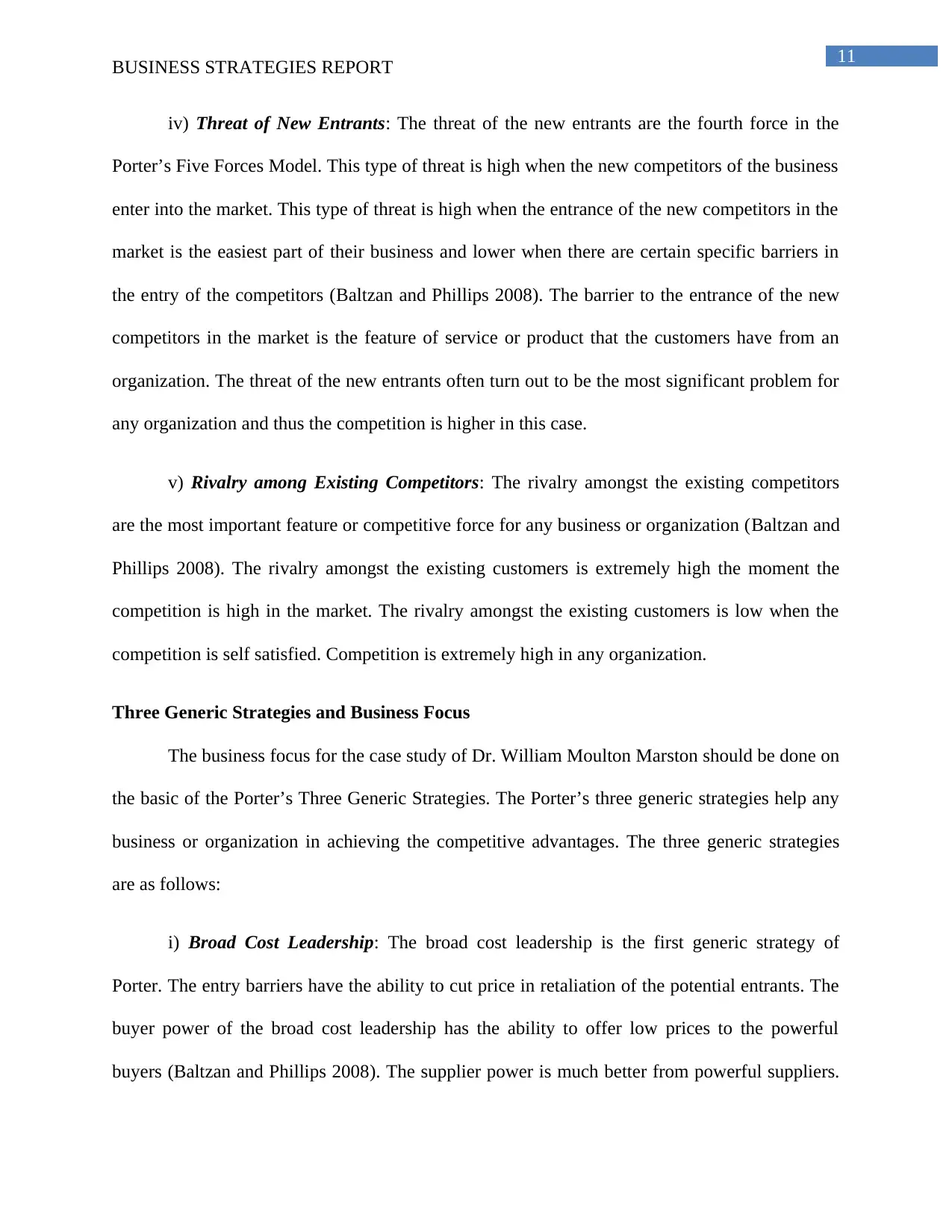
11
BUSINESS STRATEGIES REPORT
iv) Threat of New Entrants: The threat of the new entrants are the fourth force in the
Porter’s Five Forces Model. This type of threat is high when the new competitors of the business
enter into the market. This type of threat is high when the entrance of the new competitors in the
market is the easiest part of their business and lower when there are certain specific barriers in
the entry of the competitors (Baltzan and Phillips 2008). The barrier to the entrance of the new
competitors in the market is the feature of service or product that the customers have from an
organization. The threat of the new entrants often turn out to be the most significant problem for
any organization and thus the competition is higher in this case.
v) Rivalry among Existing Competitors: The rivalry amongst the existing competitors
are the most important feature or competitive force for any business or organization (Baltzan and
Phillips 2008). The rivalry amongst the existing customers is extremely high the moment the
competition is high in the market. The rivalry amongst the existing customers is low when the
competition is self satisfied. Competition is extremely high in any organization.
Three Generic Strategies and Business Focus
The business focus for the case study of Dr. William Moulton Marston should be done on
the basic of the Porter’s Three Generic Strategies. The Porter’s three generic strategies help any
business or organization in achieving the competitive advantages. The three generic strategies
are as follows:
i) Broad Cost Leadership: The broad cost leadership is the first generic strategy of
Porter. The entry barriers have the ability to cut price in retaliation of the potential entrants. The
buyer power of the broad cost leadership has the ability to offer low prices to the powerful
buyers (Baltzan and Phillips 2008). The supplier power is much better from powerful suppliers.
BUSINESS STRATEGIES REPORT
iv) Threat of New Entrants: The threat of the new entrants are the fourth force in the
Porter’s Five Forces Model. This type of threat is high when the new competitors of the business
enter into the market. This type of threat is high when the entrance of the new competitors in the
market is the easiest part of their business and lower when there are certain specific barriers in
the entry of the competitors (Baltzan and Phillips 2008). The barrier to the entrance of the new
competitors in the market is the feature of service or product that the customers have from an
organization. The threat of the new entrants often turn out to be the most significant problem for
any organization and thus the competition is higher in this case.
v) Rivalry among Existing Competitors: The rivalry amongst the existing competitors
are the most important feature or competitive force for any business or organization (Baltzan and
Phillips 2008). The rivalry amongst the existing customers is extremely high the moment the
competition is high in the market. The rivalry amongst the existing customers is low when the
competition is self satisfied. Competition is extremely high in any organization.
Three Generic Strategies and Business Focus
The business focus for the case study of Dr. William Moulton Marston should be done on
the basic of the Porter’s Three Generic Strategies. The Porter’s three generic strategies help any
business or organization in achieving the competitive advantages. The three generic strategies
are as follows:
i) Broad Cost Leadership: The broad cost leadership is the first generic strategy of
Porter. The entry barriers have the ability to cut price in retaliation of the potential entrants. The
buyer power of the broad cost leadership has the ability to offer low prices to the powerful
buyers (Baltzan and Phillips 2008). The supplier power is much better from powerful suppliers.
⊘ This is a preview!⊘
Do you want full access?
Subscribe today to unlock all pages.

Trusted by 1+ million students worldwide
1 out of 27
Related Documents
Your All-in-One AI-Powered Toolkit for Academic Success.
+13062052269
info@desklib.com
Available 24*7 on WhatsApp / Email
![[object Object]](/_next/static/media/star-bottom.7253800d.svg)
Unlock your academic potential
Copyright © 2020–2025 A2Z Services. All Rights Reserved. Developed and managed by ZUCOL.




